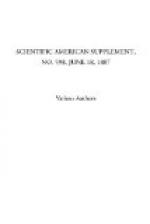ELECTRIC REGISTERING APPARATUS FOR METEOROLOGICAL INSTRUMENTS.
Mr. E. Gime, whose name is not unknown to our readers, sends us a description of a certain number of meteorological apparatus to which he has applied a peculiar method of registering that it is of interest to make known.
[Illustration: FIG. 1.—DIAGRAM OF GIME’S TELEMAREOGRAPH.]
Mr. Gime in the first place has devised a “telemareograph,” that is to say, an apparatus designed to register at a distance the curve of the motions of the tide in a given place. The structure of this device, shown diagramatically in Fig. 1, is very simple. It is divided into two distinct parts—a transmitter and a registering apparatus. The transmitter consists of a long glass tube, A, closed at one end and communicating through the other with a receptacle filled with mercury. A barometric vacuum is formed in this tube. The level of the open receptacle corresponds exactly to the level of the lowest tide.
[Illustration: FIG. 2.—THE APPARATUS WITH THREE REGISTERING STATIONS.]
Pieces of iron wire projecting sufficiently in the interior to establish good contacts with the column of mercury are fastened one millimeter apart to the inner surface of the tube. These iron contacts are connected with the divisions of a rheostat, R, arranged in a tight compartment surrounded with paraffine, near the tube.
This rheostat is interposed in the general circuit. It is connected through one extremity with the line, and through the other with a disk of copper, which has a surface of one square meter, and is immersed in the sea.
The line, L, insulated like an ordinary telegraph wire, is prolonged as far as to the registering station.
The registering apparatus consists of a solenoid, S, that acts upon a soft iron core suspended by a cord from the extremity, x, of the beam of a balance. This cord passes between the channels of two rollers designed, despite the motion of the beam, to keep the core in a vertical position in the center of the solenoid.
The opposite arm of the balance carries a sliding weight, i, that moves over a graduated scale and is designed to balance the core, N, in a certain position in regulating the motions of the curve. At its extremity it carries a style that bears against the drum, T, on which the paper is wound that is to receive the mareometric curve.
The solenoid, S, is interposed in the general circuit, being connected on the one hand with the line, L, and on the other with a very constant battery of an electromotive force proportioned to the resistance of the circuit.
Through the electrode that remains free, the battery is grounded with so great care that no variation in resistance can be produced thereby. If the station is near the sea, the conductor of this electrode may be run to a copper disk, having the same surface as the one at the transmitting station. With this description, the operation of the apparatus may be easily understood.




